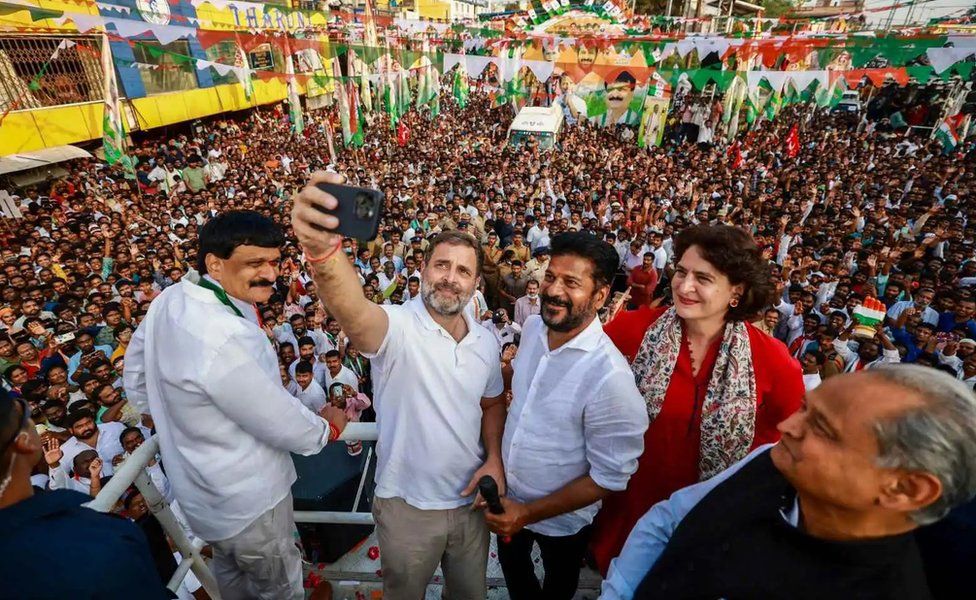Narendra Modi’s Bharatiya Janata Party (BJP) has won three of the four key state elections in India ahead of the crucial general elections next year.
The BJP retained power in Madhya Pradesh and took Rajasthan and Chhattisgarh. The main Opposition Congress ousted a regional party to win the southern state of Telangana.
More than 160 million people or a sixth of India’s electorate were eligible to vote in the polls held in November. Counting of votes for a fifth state, Mizoram, is due on Monday.
Did these elections serve a litmus test for Mr Modi’s prospects in securing a historic third term in the upcoming general elections next year? In simpler terms, would a stronger performance by the Congress have indicated a potential setback for the BJP?
Not quite. In 2018, the Congress won three key state elections – Rajasthan, Madhya Pradesh and Chhattisgarh. Three months later BJP swept the general elections nationally and in all the three states. State elections in India are fought over state or region specific concerns, while general elections revolve around more national-level issues.
Despite this dynamic, Sunday’s results come as a significant boost for Mr Modi, who is already setting his sights on a record third term next year.
The win is also significant because the BJP has frequently fallen short in state elections. Until today, the party – which enjoys a comfortable majority in parliament – governed 15 of India’s 28 states – and only nine of them directly. The rest were in coalition with smaller partners.

Regaining control of Rajasthan and Chhattisgarh from the Congress and retaining Madhya Pradesh for a record fifth term means that the BJP is looking virtually unassailable in the “Hindi heartland” of northern and central India. Ten states in this Hindi-speaking belt send 225 MPs to the parliament – and BJP won 177 of the seats in 2019.
On the other hand, the elections were more important for the Congress.
An improved performance would have come as a huge morale booster and positioned the party as the natural leader of a fledgling alliance comprising 28 opposition parties, collectively known as INDIA. At one point, the party appeared to be leading in the race to win Madhya Pradesh and subsequently lost momentum as the BJP gained ground. The party has struggled to convert state victories into success in national elections in the past, and now it is failing to retain its state governments as well. Anti-incumbency is harsher on Congress.
But there is one silver lining. The Congress managed to wrest the southern state of Telangana, where the regional BRS party suffered from anti-incumbency. After a resounding win in Karnataka in May, it continues to make inroads into southern India.
So what were the factors that shaped voting behaviour in the recent polls? Beyond a track record of governance, considerations such as caste, identity, and the allure of BJP’s Hindu nationalism, welfare promises also seem to exert influence on voting patterns.

During his campaign, Mr Modi announced that a scheme to provide 5kg of free grain a month of 800 million of India’s poorest people would continue for the next five years. The resurgence of his party in Madhya Pradesh was also credited to a programme offering a monthly stipend of 1,250 rupees [$16; £12] to eligible women from poorer families – women comprise some 47% of the 50 million voters in the state.
Many commentators called such welfarism by all parties competitive populism, but in reality it also underscored the vulnerable lives of millions of Indians who depend on state handouts to eke a decent living.
A nationwide poll by India Today magazine survey in August showed Mr Modi’s popularity remained intact after a decade in power: more than half of the respondents felt he should continue to lead India.
Adding to the BJP’s formidable arsenal are its massive resources, a mammoth 24/7 party organisation, governance anchored in a robust welfare architecture, and a largely supportive media. It’s hardly surprising that Mr Modi and his party appear to be in a pole position to win a stunning third term next year.




